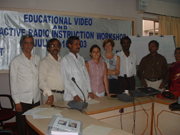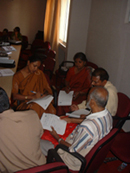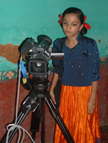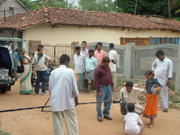Multiple Learning Channels to Attain Education For All
dot-EDU’s T4-India Project
July 2003, Bangalore

Participants of the Bangalore IRI Workshop, July 2003
India’s 2001 Census counted over one billion people within its borders. Between 1991 and 2001, its population grew by 21.34%. At the local level, such growth poses a considerable challenge to the Indian State to provide education and promote literacy, particularly in rural areas. Over the past decade and in tandem with the Education For All (EFA) Declaration, India has taken great steps in improving literacy rates and education through information communication technologies (ICTs). Building on these efforts, USAID/India, the Education Development Center and resource partners have developed a three year project to improve the reach and quality of primary school education in Chhattisgharh, Karnataka and eventually Jharkhand State. The Technology Tools for Teaching and Training (T4) in India project will provide teachers with in-service training to improve content and methods, and multichannel instruction in English, Math and Science using media ranging from interactive radio to a mobile video unit.
State and Stakeholder Participation
Before the T4 Initiative was launched, various national and State level stakeholder meetings were held to determine what type of learning technology strategy could best reach marginalized populations, especially girls. These discussions formed the basis of T4 activities, and have provided a framework for active collaboration between State representatives, education practitioners, policy makers and EDC staff and its partners. This network model supports and encourages ongoing dialogue about ICT and education, and may even lead to international exchange opportunities. Furthermore, State level education programs that already use ICT--like Karnataka’s “Keli Kali” (“Joyful Learning”) radio program—can provide valuable insights into the challenges, potential and impacts of different technologies for learning.

Educators apply their instructional skills to scriptwriting
Multiple Media for Diverse Populations
Why so many different technologies? In brief, multiple technologies represent multiple learning channels; the greater the number of channels, the greater the potential for learning. Not only is India’s population vast, it is also diverse. The over 100 million people who live in the three states belong to an array of ethnic and tribal groups with differing languages and cultures. Rather than focus on certain groups to the exclusion of others, the project will test the ability of technologies like video, hand-held tools and radio to be “repurposed”—adapted for use with different populations. The T4 Initiative will initially focus on instruction via video and computer where possible, and radio and print media in those areas that lack adequate infrastructure. In every instance, learning channels that offer high quality, structured instruction will be used. An evaluation will be conducted to compare the effectiveness of the different combinations of learning channels.

Language, Gender and Content
Content development in local languages will address the language barriers multilingual teachers encounter in the classroom. Nadya Karim-Shaw, EDC Project Manager explains, “For example, in the case of English language instruction, the word ‘train’ doesn’t exist in the local languages of Halbi and Gondi. So, the question of how to teach in what is often an instructor’s third language (English) will be overcome by getting teachers who come from Halbi and Gondi-speaking areas, in this case, to work on content development.” This type of collaboration ensures that differences in vocabulary do not lead to gaps in knowledge. Furthermore, statistics consistently show lower enrollment and higher dropout figures for girls. Teachers, researchers, principals and State representatives attribute low participation of girls to a lack of self-confidence and self-esteem, particularly for girls from tribal areas. To address this and other related issues, gender-specific content will be integrated into both training and teaching programs. This content will help students and teachers deal with gender/tribal issues appropriately and constructively.
Building Capacity
In order to ensure lifelong learning, capacity building is integral to the T4 Initiative. Producers are now being trained in scriptwriting for educational video instruction and interactive radio instruction. The scripts they produce will use a “dual audience” approach, in which resource materials like interactive radio and print materials are used directly with students, but explain and demonstrate instruction methods to teachers throughout the broadcasts or exercises. Students will also have the chance to build their digital video skills, using video not only for school-related work but also to film and evaluate their progress over time.

Workshop participants learn camera operating techniques
In addition to the learning activities to be implemented in the three states, the dot-EDU project is part of a pilot group for Edusat. The Edusat satellite, built by the Indian Space Research Organization (ISRO), is wholly dedicated to meet the needs of the education sector in the country. On-the-ground infrastructure is being built to receive the high quality math, science and English primary education modules developed through the T4 project. The Edusat network provides six exclusive channels for primary, secondary, higher education, technical education and e-governance.
The dot-EDU Technology Tools for Teaching and Training Initiative represents an extremely innovative and ambitious effort to meet India’s challenge to provide primary education to all of its children. If successful, it will not only reach formerly underserved populations, but will become an educational model for other developing nations.
For more information, please contact:
- EDC Vandita Sharma, Chief of Party, vsharma@edc.org
- EDC Nadya Karim-Shaw, Project Director, nkarim-shaw@edc.org
- Project Coordinator, Hetal Thukral, hthukral@edc.org
